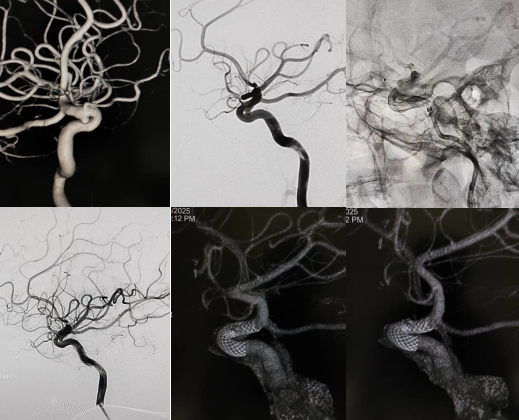In September 2025, the team from the Department of Neurology at the First Affiliated Hospital (FAH) of Xi’an Jiaotong University (XJTU), led by Prof. Han Jianfeng and Prof. Yu Jia, successfully performed surgery on a patient with an intracranial aneurysm using the innovative Repath flow-diverting device. This case marked the first clinical application of the Repath flow-diverting device in Northwest China, signifying the neurointerventional team of the Department of Neurology at the FAH now ranks among the national leaders in the interventional treatment of intracranial aneurysms.

A 51-year-old female patient was admitted to the hospital with mild headache and showed significant improvement after symptomatic treatment. Head MRA revealed an intracranial aneurysm, and she subsequently sought further diagnosis and treatment at the FAH. Head DSA confirmed an aneurysm in the ophthalmic segment of the left internal carotid artery, measuring approx. 3.60 mm×3.16 mm. After communications, the patient and her family consented to surgical treatment.
Prof. Han Jianfeng and Prof. Yu Jia, leading team members Dr. Sun Peng, Dr. Song Wenfeng and Dr. Chen Chen, performed implantation of the Repath flow-diverting device with the support of the Department of Anesthesiology and Perioperative Medicine and the Interventional Surgery Unit. The procedure was completed smoothly, with excellent stent apposition. Postoperatively, the patient was transferred to the neurology intensive care unit (ICU) for close monitoring, and subsequently moved to the general ward the following day. She has since made a full recovery and has been discharged from the FAH.

The advent of flow-diverting, high-mesh stents has shifted the treatment strategy for aneurysms from intra-aneurysmal coil embolization to parent-artery reconstruction, offering new concepts and approaches for the endovascular treatment of complex aneurysms. The Repath flow-diverting stent has several key advantages. It enables in-situ deployment technology. Its cobalt-chromium alloy structure provides clear radiopacity, allowing operators to more easily and accurately identify the release point and anchoring position of the stent. The distal tip guidewire can be reshaped to better adapt to angulated distal vessels of the parent artery. A high retrievability rate of up to 98% facilitates precise stent placement. The flow-diverting, high-mesh stents have already demonstrated good safety and efficacy in clinical applications.